Nahirnick, N.K.; Hunter, P.; Costa, M.; Schroeder, S., and Sharma, T., 2019. Benefits and challenges of UAS imagery for eelgrass (Zostera marina) mapping in small estuaries of the Canadian West Coast. Journal of Coastal Research, 35(3), 673–683. Coconut Creek (Florida), ISSN 0749-0208.
Seagrasses are a fundamental component of nearshore marine habitats, and as such, concerted effort has been put into developing remote sensing methods to assess the spatial coverage of these important habitats. However, in small coastal bays, traditional aerial or satellite remote sensing can be cost-prohibitive or lack sufficient spatial resolution to detect the small, fringing, and often patchy eelgrass (Zostera marina) meadows. This paper presents a method for collection and processing of unoccupied aerial system (UAS) imagery used to map eelgrass at three small coastal estuaries in the Salish Sea of British Columbia. A low-cost, consumer-grade UAS platform equipped with a GoPro Hero 3+ was used to acquire images with a ground resolution of 2 cm, which were postprocessed using structure-from-motion techniques into georeferenced orthomosaics. A manual classification approach incorporating segmented image objects was used to classify eelgrass on a presence or absence basis, resulting in overall mapping accuracies of 96.3%, 86.5%, and 89.7%, as determined by field validation using kayak videography. The major benefit of this method was fine spatial resolution that allowed for textural discrimination between spectrally similar species. However, eelgrass detection and overall accuracy was found to be highly influenced by the environmental conditions at the time of image acquisition.





